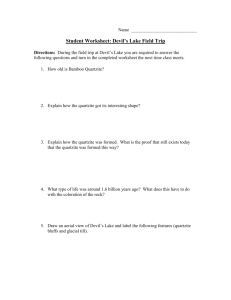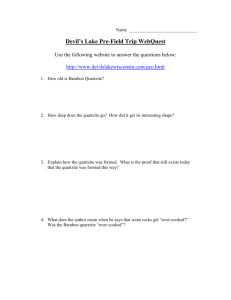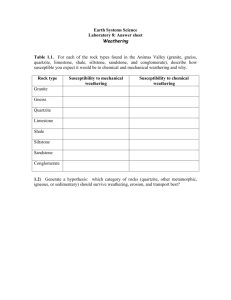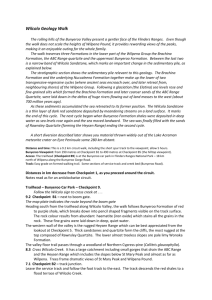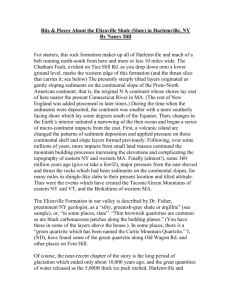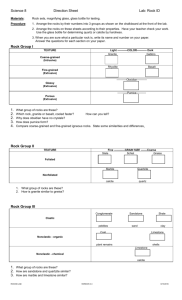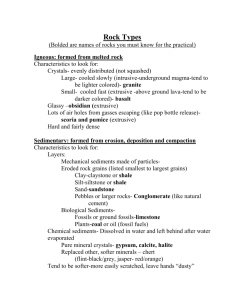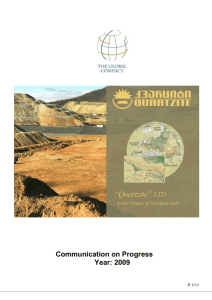MountBrown - Walking Trails Support Group
advertisement
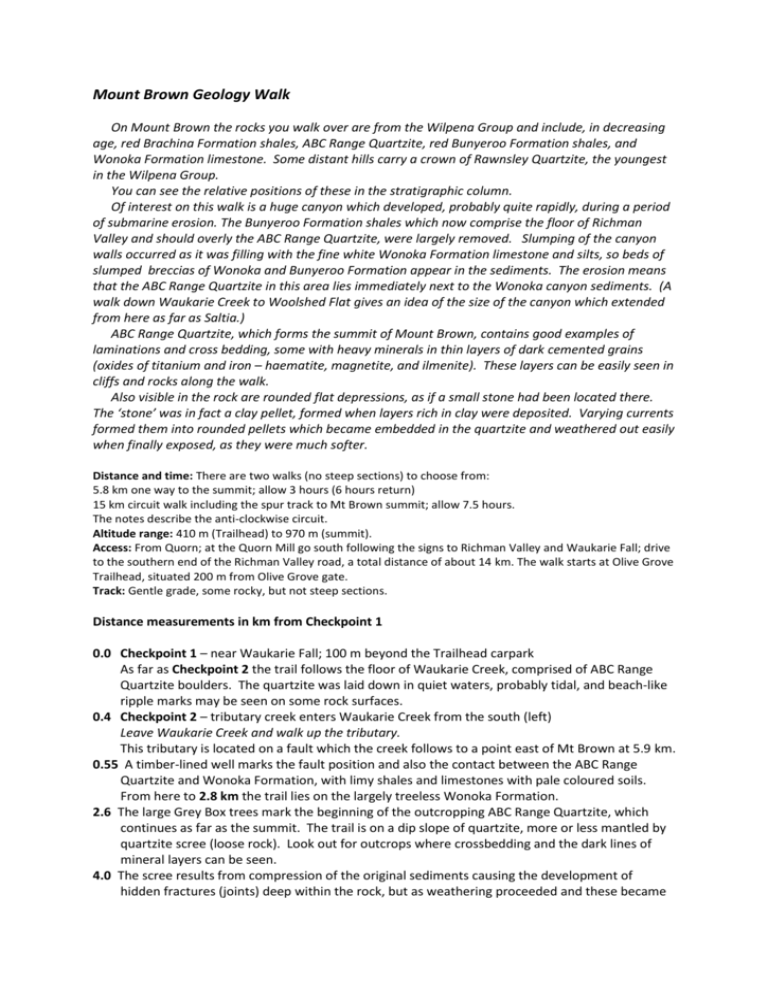
Mount Brown Geology Walk On Mount Brown the rocks you walk over are from the Wilpena Group and include, in decreasing age, red Brachina Formation shales, ABC Range Quartzite, red Bunyeroo Formation shales, and Wonoka Formation limestone. Some distant hills carry a crown of Rawnsley Quartzite, the youngest in the Wilpena Group. You can see the relative positions of these in the stratigraphic column. Of interest on this walk is a huge canyon which developed, probably quite rapidly, during a period of submarine erosion. The Bunyeroo Formation shales which now comprise the floor of Richman Valley and should overly the ABC Range Quartzite, were largely removed. Slumping of the canyon walls occurred as it was filling with the fine white Wonoka Formation limestone and silts, so beds of slumped breccias of Wonoka and Bunyeroo Formation appear in the sediments. The erosion means that the ABC Range Quartzite in this area lies immediately next to the Wonoka canyon sediments. (A walk down Waukarie Creek to Woolshed Flat gives an idea of the size of the canyon which extended from here as far as Saltia.) ABC Range Quartzite, which forms the summit of Mount Brown, contains good examples of laminations and cross bedding, some with heavy minerals in thin layers of dark cemented grains (oxides of titanium and iron – haematite, magnetite, and ilmenite). These layers can be easily seen in cliffs and rocks along the walk. Also visible in the rock are rounded flat depressions, as if a small stone had been located there. The ‘stone’ was in fact a clay pellet, formed when layers rich in clay were deposited. Varying currents formed them into rounded pellets which became embedded in the quartzite and weathered out easily when finally exposed, as they were much softer. Distance and time: There are two walks (no steep sections) to choose from: 5.8 km one way to the summit; allow 3 hours (6 hours return) 15 km circuit walk including the spur track to Mt Brown summit; allow 7.5 hours. The notes describe the anti-clockwise circuit. Altitude range: 410 m (Trailhead) to 970 m (summit). Access: From Quorn; at the Quorn Mill go south following the signs to Richman Valley and Waukarie Fall; drive to the southern end of the Richman Valley road, a total distance of about 14 km. The walk starts at Olive Grove Trailhead, situated 200 m from Olive Grove gate. Track: Gentle grade, some rocky, but not steep sections. Distance measurements in km from Checkpoint 1 0.0 Checkpoint 1 – near Waukarie Fall; 100 m beyond the Trailhead carpark As far as Checkpoint 2 the trail follows the floor of Waukarie Creek, comprised of ABC Range Quartzite boulders. The quartzite was laid down in quiet waters, probably tidal, and beach-like ripple marks may be seen on some rock surfaces. 0.4 Checkpoint 2 – tributary creek enters Waukarie Creek from the south (left) Leave Waukarie Creek and walk up the tributary. This tributary is located on a fault which the creek follows to a point east of Mt Brown at 5.9 km. 0.55 A timber-lined well marks the fault position and also the contact between the ABC Range Quartzite and Wonoka Formation, with limy shales and limestones with pale coloured soils. From here to 2.8 km the trail lies on the largely treeless Wonoka Formation. 2.6 The large Grey Box trees mark the beginning of the outcropping ABC Range Quartzite, which continues as far as the summit. The trail is on a dip slope of quartzite, more or less mantled by quartzite scree (loose rock). Look out for outcrops where crossbedding and the dark lines of mineral layers can be seen. 4.0 The scree results from compression of the original sediments causing the development of hidden fractures (joints) deep within the rock, but as weathering proceeded and these became exposed, water and ice separated the blocks along the joints. Slopes of loose boulders have resulted. 4.75 Checkpoint 4 – spur track up to Mt Brown summit Follow distance markers up to the summit; it is 2 km return to this point. As you approach the top of the hill, good quartzite outcrops are more frequent. 5.8 Checkpoint 5 – summit at 970 m A dip slope of slabby quartzite forms the foundations for the lookout and the old survey marker. To the south a cliff overlooks rolling hills of underlying Brachina Formation and Wilmington Formation siltstones. The lookout celebrates botanist Robert Brown’s visit in 1802 as part of Matthew Flinders’ exploration of Upper Spencer Gulf. From the top can be seen (bearings are magnetic): Wilpena Pound 27° 115 km Watts Sugarloaf in the Black Jack Range 27° 60 km Horseshoe Range (Moockra Tower) 65° 39 km Coonatto Creek and Hammond 86° 30 km Mt Remarkable 149° 36 km Point Bonython 196° 58 km Whyalla 210° 71 km Devils Peak (below horizon) and the Dutchmans Stern Range beyond 344° 10 km, 22 km Richman Valley, Quorn 360° 8 km, 18 km It is worth noting that the youngest (top most) sediments of the Wilpena Group (Rawnsley Quartzite) form the summit of Devil’s Peak (680 m), which is now lower than both Mt Brown (970 m) and Moockra Tower (768 m). These are ABC Range Quartzite hills which have been uplifted to their present position by massive earth movements and folding starting about 450 million years ago. Such readjustments of the sediment pile are probably still continuing. Rawnsley Quartzite sediments would have been removed from Mt Brown and other hills in this district. Return to Checkpoint 4 and turn east. The trail follows around the base of the quartzite, which is gradually replaced by Brachina Formation siltstone, and woodland gives way to open slopes. 5.9 trail crosses a saddle comprised of the siltstone. Here fine sediments were laid down in a calmer, deep-water environment compared with the deltas and estuaries of the ABC Range Quartzite, giving rise to laminated shale, siltstone and fine grained sandstone. These sediments are always below those of the ABC Range Quartzite. This saddle marks the headwaters of the creek on which the well was situated at 0.55 km. As mentioned earlier the creek has exploited a faultline. 6.0 Views north across Richman Valley and Quorn to Yappala Range near Hawker, the Elder Range Rawnsley Bluff and Wilpena Pound, all topped by Rawnsley Quartzite. 6.2 Returning to the quartzite a rocky, wooded slope continues to take you east on a dip slope of ABC Range Quartzite, with small cliffs up slope and large boulders. 7.4 As you walk on from this point look for clay pellet impressions in flat slabby beds crossed by the track to Checkpoint 6 7.5 Checkpoint 6 – ridge junction; change in direction There are opportunities here to gaze across the Willochra Plain to the east, and south to Mount Remarkable at 960 m almost as high as Mount Brown (970 m), but composed of a quartzite much lower down in the sediment pile and in the Burra Group (Bungaree Quartzite). Return to Checkpoint 1 down a dip slope of ABC Range Quartzite (part of the western arm of the Quorn Syncline which forms Richman Valley. There are many good examples of cross bedding, heavy mineral lamination and clay pellet impressions alongside the track. 10.4 – 10.6 Views north to Richman Valley, west to Northern Power Station, and north-west to Tent Hill beyond Port Augusta on clear days. 13.0 Checkpoint 1 – near Waukarie Fall. Text prepared from field notes supplied by Nick Langsford GLOSSARY OF GEOLOGICAL TERMS For components of different rock Formations and Groups, see Stratigraphic Column breccia Broken up rock; can form by a wide range of processes cross bedding Mini-deltas (centimetre to metre scale) where the bedding traces, often outlined by dark heavy minerals, occur at a considerable angle to the originally horizontal bedding dip slope Where the bedding is parallel to land surface, and is not flat. fault, fault line, fault plane, fault zone A fault is a physical break in a body of rock. Faults may be of huge displacement, many kilometres (e.g. Paralana Fault), or only a few centimetres. Formation A sedimentary or volcanic rock unit which can be physically mapped and defined by features observed in the field. Group A unit which includes two or more Formations of usually sedimentary rocks Haematite Dark grey iron oxide; when scratched it shows a red streak. Not magnetic. Haematite in the Flinders Ranges commonly has a shiny mica-like habit and is called specularite. ilmenite – iron-titanium oxide Dark to shiny grey. Weakly magnetic, no red streak. iron A metallic element, Fe. Important industrial commodity. laminations, laminated Thin, regularly banded layers of sediment; almost always reflects bedding. limestone Sedimentary rock mainly made up of calcium carbonate, CaCO3 magnetite Magnetic iron oxide Precambrian Period Pre-543 milliion years ago, which is the base of the Cambrian. quartzite A rock which was originally quartz sandstone which has been heated or compressed sufficiently to fuse the grains together, producing a tough resistant rock. syncline A concave downwards fold. scree Broken rock which accumulates along the foot of and on steep slopes. shale A sedimentary rock largely made up of very fine grained material which includes a large proportion of clay minerals, micas and quartz. siltstone A rock composed of silt-sized (less than 0.1 mm) mineral grains, usually mainly quartz. titanium A metallic element, Ti; component of ilmenite.
